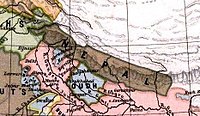1951 Nepalese revolution
| 1951 Nepalese Revolution | |||||||
|---|---|---|---|---|---|---|---|
| Part of the King Tribhuvan | |||||||
| |||||||
| Belligerents | |||||||
| Rana dynasty | Nepali Congress | ||||||
| Commanders and leaders | |||||||
|
Mohan Shumsher | Nepali Congress leader | ||||||
| Casualties and losses | |||||||
|
Military dead: 1600 |
Military dead: 900 | ||||||
| History of Nepal |
|---|
 |
|
|
The revolution of 1951 (Nepali: सात सालको क्रान्ति, romanized: Sāta Sālako Krānti) in Nepal, also referred to as Sat Salko Kranti, was a political movement against the direct rule by the Rana dynasty of Nepal which had lasted for 104 years. It marks the beginning of the political awakening and democratic movements in Nepal, and resulted in immediate abolition of the institutionalized hereditary Prime Minister system in Nepal.
Background of Rana regime
The rise of the Ranas was heightened by plotting the Kot massacre by Jung Bahadur Rana and his brothers gained power, thus reduced the power of Nepalese monarch to a figurehead, and the position of Prime Minister was made powerful and hereditary. The Rana regime pursued a policy of isolating Nepal from external influences. The Ranas further established their power by turning pro-British, and assisted the British during the Sepoy Rebellion in 1857.
Organization for revolution
Popular dissatisfaction with the Ranas began to surface among educated individuals, including many from within the Rana ruling class who supported more democratic views. Some Nepalese who had participated in the
Uprisings and incidents
Nepal Praja Parishad
The founding of the Nepal Praja Parishad was proposed by
National congress
On January 26, 1947, the Nepali National Congress was formed in India under the leadership of
Jayatu Sanskritam
In June 1947, students enrolled in the Tin Dhara school launched the
King Tribhuvan's exile

Nepali Congress's Liberation Army
After King Tribhuvan fled to the Indian embassy, the
Delhi Accord
After a mutual agreement between Ranas, Nepali Congress and King Tribhuvan, a tripartite agreement was signed in Delhi. Finally, On February 18, 1951 (7th Falgun 2007 B.S.), King Tribhuvan returned to Nepal as head of state. The major provisions of the Delhi Accord (Agreement) are as follows:
- An elected constituent assembly will create a democratic constitution within 2 years.
- There will remain an interim cabinet (government) of 10 ministers under the Prime Ministership of Mohan Shumsher, of which 5 ministerial positions will be taken by the Nepali Congress.
- There will be no restriction to political organizations. All the political prisoners will be set free and agitators have to hand over all their weapons to the government.
- King Tribhuvan will remain the king of Nepal and ultimate power lies in the monarch.
Formation of the Coalition Government
On 15 February 1951, King Tribhuvan and the leading members of the Nepali Congress returned to
From the Ranas:
- 1. Mohan Shumsher Jung Bahadur Rana - Prime Minister and Foreign Affairs
- 2. Baber Shumsher Jung Bahadur Rana- (younger brother of Mohan Shamsher; was in line for the next premiership) - Defence
- 3. Chudraj Shamsher - ("B" class Rana representative) - Forests
- 4. Nripa Janga Rana - ("C" class Rana representative) - Education
- 5. Yagya Bahadur Basnyat - (Rana Bhardar) - Health and Local self-government
From the Nepali Congress side:
- 1. B.P. Koirala - Home[10]
- 2. Subarna Shamsher Rana- (even though a Rana, he was a key member of the Nepali Congress) - Finance
- 3. Ganesh Man Singh - Commerce and Industry
- 4. Bharatmani Sharma - Food and Agriculture
- 5. Bhadrakali Mishra - Transport
This cabinet was reshuffled on 10 June 1951 to replace Baber Shamsher by Shangha Shamsher and Bharatmani Sharma by Surya Prasad Upadhyaya
Aftermath
The coalition was a mixture of conservative Ranas, who were trying to hold on to as much political power as possible, and radical reformers, who had almost no administrative experience. It was able to enact a new constitution entitled the Interim Government of Nepal Act 1951, drafted with the help of Indian experts and was in many ways inspired by the Constitution of India. This interim government was able to set up a separate judicial branch and importantly transfer all executive powers back to the king, including supreme command of the armed forces and power to appoint government officials and manage finances. Later, the entire bloc of Nepali Congress Party ministers resigned in November, which allowed the king to appoint a new government for the first time since the nineteenth century. The king used the opportunity to exclude for good the conservative Rana power bloc. A royal proclamation on November 16, 1951, established a new government led by Matrika Prasad (M.P.) Koirala, the half-brother of B.P. Koirala, who had run the Nepali Congress Party during the revolutionary struggle.
See also
- Nepali Congress
- Biratnagar jute mill strike
- Ram Prasad Rai
- List of Nepali democratic movement (1951) activists
References
- ISBN 9780415085762
- ^ Asha, S.P. Hami Le Prajatantra Kasari Lyayau. Kathmandu: Sanhila Prakashan.
- ^ a b Bhuwan Lal Joshi; Leo E. Rose (1966). Democratic Innovations in Nepal: A Case Study of Political Acculturation. University of California Press. GGKEY:5N30S3HU9BC.
- ^ Samiti, Rastriya Samachar (15 June 2017). "Jayatu Sanskritam marked". The Himalayan Times. Retrieved 2 December 2018.
- ^ Samiti, Rastriya Samachar (15 June 2017). "Jayatu Sanskritam marked". myRepublica. Retrieved 4 December 2018.
- ISBN 9780295743097. Retrieved 2 December 2018.
- ^ Adhikari, Radheshyam (30 June 2017). "Shuttered schools | From the Nepali Press | Nepali Times". archive.nepalitimes.com. Retrieved 2 December 2018.
- ^ cheena (23 June 2009). "Nepal". cheena-nepal.blogspot.com.
- ISBN 978-1-134-88533-6.
- ^ "Nepali Congress".
